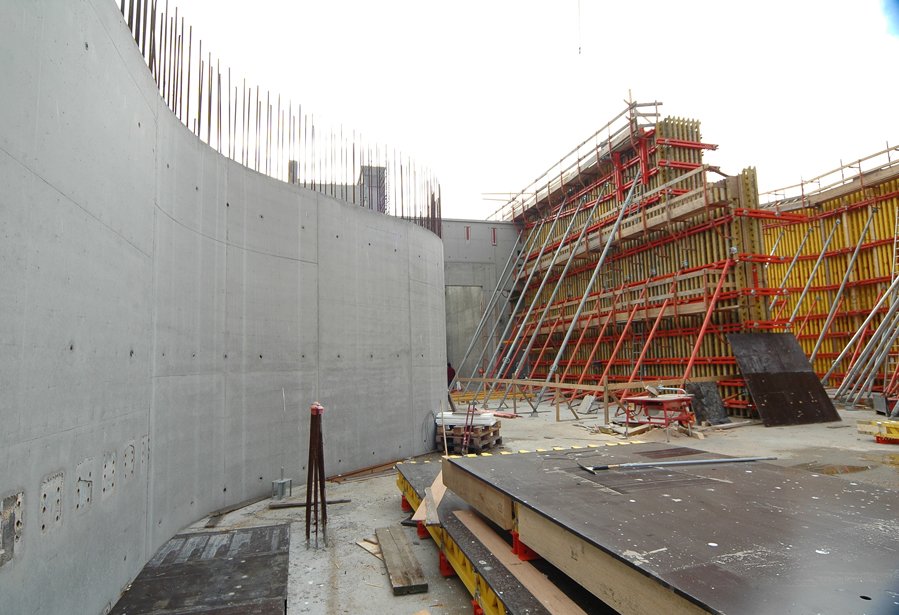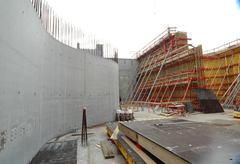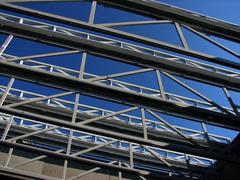
MAXXI Rome: Visiting Hours, Tickets, and Guide to Rome’s Premier Contemporary Art Museum
Date: 14/06/2025
Introduction: MAXXI Rome Overview
Located in the vibrant Flaminio district, the MAXXI – Museo nazionale delle arti del XXI secolo – is Italy’s national museum dedicated exclusively to contemporary art, architecture, and photography. Opened in 2010, MAXXI fills a unique cultural role in Rome, a city long celebrated for its classical and Renaissance treasures but previously lacking a modern public space for 21st-century creativity. Commissioned by the Italian Ministry for Cultural Heritage in the late 1990s, MAXXI was realized through an international design competition won by Zaha Hadid, whose bold, fluid architectural vision has set a new benchmark for museum design (Inexhibit; Architectural Review).
MAXXI’s innovative architecture—with its sweeping concrete curves, dynamic interior spaces, and abundant natural light—offers visitors an immersive journey that blurs the boundaries between art, architecture, and the surrounding city (Arch2O; archeetect.com). The museum’s extensive collections, rotating exhibitions, and educational programs make it a must-visit destination for art enthusiasts and cultural travelers alike. This comprehensive guide covers MAXXI’s history, architectural highlights, collections, exhibitions, practical visitor information, and tips for exploring nearby Rome historical sites.
Contents
- Origins and Vision: The Birth of MAXXI
- Architectural Significance and Design
- Visiting MAXXI: Hours, Tickets, and Accessibility
- The MAXXI Collections
- 2025 Must-See Exhibitions
- Nearby Attractions and Travel Tips
- FAQs
- Visual Highlights
- Related Articles
- Plan Your Visit and Stay Connected
Origins and Vision: The Birth of MAXXI
A Contemporary Institution for Rome
Rome’s artistic legacy is unparalleled, yet until the 21st century, it lacked a major national institution for contemporary art and architecture. Recognizing this gap, the Italian Ministry for Cultural Heritage launched the MAXXI project in the late 1990s (Inexhibit). The goal was to create a space that celebrated modern creativity and engaged with the cultural pulse of the present.
International Competition and Site Selection
In 1998, an international competition attracted 273 proposals from leading architects worldwide (Arquitectura Viva). Zaha Hadid’s winning design envisioned the museum as a “field of buildings” with interwoven, sinuous forms, rather than a traditional static box (WikiArquitectura). The site—once a military barracks—was strategically chosen in the Flaminio district, an area undergoing urban renewal and close to other cultural venues (Inexhibit).
Construction and Inauguration
Despite political and economic obstacles, including negotiations for the site and shifting government priorities, construction commenced in the early 2000s and lasted over a decade (WikiArquitectura; Arquitectura Viva). MAXXI officially opened on May 28, 2010, to critical acclaim and international recognition (Inexhibit).
Mission and Legacy
MAXXI operates as a foundation under the Ministry of Culture (Wikipedia), with a mission to collect, conserve, study, and exhibit contemporary works, as well as foster creativity and public engagement (MAXXI Official). The museum has since expanded its collection, earned prestigious accolades like the RIBA Stirling Prize, and opened a branch in L’Aquila, further cementing its legacy as an innovative cultural center (ArchDaily; Wikipedia).
Architectural Significance and Design
Vision and Spatial Organization
Zaha Hadid’s design for MAXXI is renowned for its non-linear, organic spatial arrangement (Architectural Review). Galleries, walkways, and communal spaces flow into each other, encouraging exploration and new perspectives on art and architecture. The building’s intersecting concrete ribbons, floating staircases, and bridges create a sense of movement and openness (archeetect.com).
Materiality and Light
Exposed concrete and expansive glass roofs define MAXXI’s visual identity. Natural light floods the galleries, highlighting both the building’s sculptural qualities and the artworks within (theaficionados.com; Architectural Record). The interplay of light and shadow adds drama and depth to every visit.
Integration and Flexibility
The museum is integrated into Rome’s urban grid, with a public forecourt that blurs the line between city and museum (theaficionados.com). Flexible galleries support diverse exhibitions, and multi-use spaces—including an auditorium, library, and café—position MAXXI as a true cultural hub (Arch2O).
Sustainability and Future Developments
MAXXI continues to innovate with projects like “Grande MAXXI,” a €37.5 million initiative to enhance sustainability, accessibility, and community engagement (italia.it).
Visiting MAXXI: Hours, Tickets, and Accessibility
Opening Hours
- Tuesday–Sunday: 11:00 AM–7:00 PM (last entry at 6:00 PM)
- Thursday: Extended hours to 10:00 PM
- Closed on Mondays and major holidays
Tickets
- General Admission: €12
- Reduced (EU citizens aged 18–25): €8
- Temporary Exhibition Access: Up to €15 depending on the show
- Free Entry: Under 18s, Rome residents under 25, and every first Sunday of the month
- Purchase: Online in advance is recommended (MAXXI Tickets)
Accessibility
MAXXI is fully accessible, with ramps, elevators, and dedicated services for visitors with disabilities. Guided tours are available in multiple languages, including Italian Sign Language (LIS) (MAXXIperTUTTI).
Getting There
- Address: Via Guido Reni, 4A, Flaminio district, Rome
- By Public Transport: Metro Line A (Flaminio stop), buses 52, 53, 223, 910
- Parking: Limited; public transport is recommended
The MAXXI Collections
Art
MAXXI’s art collection features major Italian and international artists, including Alighiero Boetti, Anish Kapoor, William Kentridge, and Gerhard Richter. The collection spans painting, sculpture, video, installation, and performance, with thematic displays and regularly updated exhibitions (MAXXI Art Collection).
Architecture
The Architecture Collection includes drawings, models, and archival documents by figures such as Aldo Rossi, Pier Luigi Nervi, Renzo Piano, and Zaha Hadid. Exhibitions like “Stadi: Architecture of a Myth” explore the cultural and social significance of the built environment (MAXXI Architecture Collection).
Photography
With approximately 2,400 works, MAXXI’s photography holdings document contemporary society and the urban environment through the eyes of Gabriele Basilico, Letizia Battaglia, Iwan Baan, and others (MAXXI Photography Collection).
Permanent and Thematic Displays
Since 2015, the museum has presented its collections in innovative, rotating layouts, fostering interdisciplinary conversations between art, architecture, and photography. Notable is “Collezione MAXXI: The Large Glass,” curated by Alex Da Corte (Collezione MAXXI: The Large Glass).
2025 Must-See Exhibitions at MAXXI
Memorabile. Ipermoda (Memorable. Hyperfashion)
Curated by Maria Luisa Frisa with the Camera Nazionale della Moda Italiana, this exhibition explores the impact of contemporary fashion on culture, memory, and identity. Highlights include iconic garments, interactive installations, and discussions on ethics and innovation.
- Dates: Through March 23, 2025
- Tickets: Full €12; Reduced €8
- More info: Secret Roma – Memorable (Hypermoda); ImFirenzeDigest
Unstable Architecture
Curated by Diller Scofidio + Renfro, “Unstable Architecture” presents adaptable, interactive structures that redefine the relationship between people and built space.
- Dates: Until July 27, 2025
- Tickets: Full €15; Reduced €10
- More info: Secret Roma – Unstable Architecture
The Large Glass: New Permanent Display
A fresh, rotating presentation of MAXXI’s core collection, offering new perspectives and accessibility features, including guided tours in LIS (MAXXI Events – The Large Glass).
Estate al MAXXI: Summer at MAXXI
From June to September, MAXXI’s summer program features outdoor installations, cinema, concerts, and literary events (MAXXI Events – Estate al MAXXI).
Romaeuropa Festival Collaborations
In partnership with the Romaeuropa Festival, MAXXI hosts performance art, workshops, and cross-disciplinary cultural events (MAXXI Events – Romaeuropa Festival).
Educational & Family-Focused Programs
Inclusive workshops, creative labs, and storytelling events are available year-round, with special programs for families and children, and accessibility initiatives like MAXXIperTUTTI.
Nearby Attractions and Travel Tips
MAXXI is well-placed for exploring other cultural sites, including:
- Auditorium Parco della Musica: Renzo Piano’s celebrated concert venue
- Villa Borghese Gardens: Rome’s iconic park
- Piazza del Popolo: Historic piazza with shops and cafes
The Flaminio district offers lively streets and local eateries, perfect for a full day of art and culture (romeonfoot.com; Travel Vibe).
Frequently Asked Questions (FAQ)
Q: What are MAXXI’s visiting hours?
A: Tuesday–Sunday, 11:00–19:00 (last entry at 18:00); extended to 22:00 on Thursday; closed Mondays.
Q: How much are MAXXI tickets?
A: General admission €12; reduced €8 for EU citizens 18–25; free for under 18s, Rome residents under 25, and first Sunday each month.
Q: Is the museum accessible?
A: Yes, with full wheelchair access, ramps, elevators, and services for visitors with disabilities.
Q: Are guided tours available?
A: Yes, in multiple languages, including Italian Sign Language (LIS); audio guides also available.
Q: Can I take photos?
A: Yes, photography without flash is permitted in most areas.
Q: How do I get to MAXXI?
A: Take Metro Line A to Flaminio or use bus lines 52, 53, 223, 910.
Visual Highlights
[Image: Exterior view of MAXXI Museum Rome with Zaha Hadid’s iconic curves]
Alt text: MAXXI Museum Rome contemporary architecture exterior
[Image: Interior gallery flooded with natural light]
Alt text: MAXXI Museum interior with dynamic lines and open spaces
[Image: Map showing MAXXI’s location in Flaminio district]
Alt text: Map of MAXXI Museum and nearby cultural landmarks
Related Articles
Plan Your Visit and Stay Connected
Enhance your MAXXI experience by downloading the Audiala app for real-time exhibition updates, audio guides, and exclusive tips. Stay up-to-date by following MAXXI and Audiala on social media for behind-the-scenes content and visitor offers.
Summary and Call to Action
MAXXI stands as Rome’s beacon for contemporary art and architecture, bridging the city’s storied past with the dynamic energy of today’s creative world (Inexhibit; Wikipedia; Architectural Review). Its innovative architecture, diverse collections, engaging exhibitions, and inclusive programs make it an essential stop for every visitor. Plan ahead using the official MAXXI website and the Audiala app to get the most out of your visit.
Official Sources and Further Reading
- MAXXI Museum Rome: Inexhibit
- MAXXI by Zaha Hadid: Architectural Review
- MAXXI Official Website
- Secret Roma – Art Exhibitions in Rome
- MAXXI Museum Information: RomeOnFoot
- MAXXI Sustainability: Italia.it
- MAXXI Tickets & Events
- Travel Vibe: Art Museums in Rome



















































































































































































































































